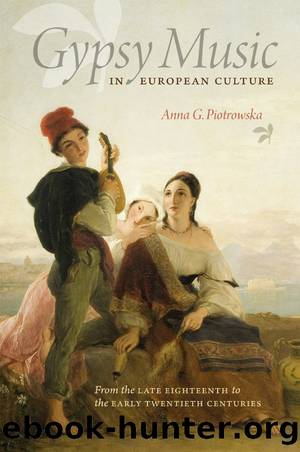Gypsy Music in European Culture by Piotrowska Anna G.;Torr Guy R.;

Author:Piotrowska, Anna G.;Torr, Guy R.;
Language: eng
Format: epub
Publisher: Northeastern University Press
The National Element: Manuel de Fallaâs La Vida Breve
The Workâs Origin
In 1904, the Academy of Fine Arts in Madrid announced a competition for best dramatic work by a Spanish composer. The next year, Manuel de Falla won the competition with an opera, with a libretto by Carlos Fernández-Shaw, titled La vida breve (Life Is Short). But the opera would not be staged for another several years, and this staging was only spurred by de Fallaâs other compositional successes, largely achieved abroad. Only after its 1913 premiere in Nice would appreciation for the work take hold in Spain. Later, the opera was performed in Paris, with a French adaptation of the libretto by Paul Milliet.
From the start, critics from Spain and abroad recognized the operaâs Spanish character. Edgar Istel, for example, pointed to the predominance of âlocal colorâ in the libretto, and its particular aim of showing the beauty of Andalusia (Istel 1929, 505). In both the music and the libretto, Istel noted the accentuation of Gypsy culture.
As for its plot, the two-act opera told a rather simple tale of love and betrayal, opening up the libretto to charges of containing weak and conventional subject matter (Weber 2000, 154). The story line has much in common with Bizetâs Carmen: set in Spain, the action centers on the Gypsy connotations of the central hero, a woman. Whereas in Bizetâs opera Carmen is the driver of misfortune, de Fallaâs Salud ends up the victim of her own longings. Yet, symptomatically, in both works the women ultimately die rather than the men.
The protagonists of Bizetâs and de Fallaâs operas are different in other ways. While the fiery Gypsy Carmen embodies a full-bodied Spanishness (Pahlen 1953, 104), Salud is seen as an ordinary Spanish girl living in AlbaicÃn, the Gypsy part of Granada. As it happened, âordinary Spanish (or Andalusian) girlâ was often morphed by commentators into âsimple Gypsy girlâ (Mayer-Serra 1943, 3; Istel 1929, 505).
The plot details reinforce associations of Salud with Gypsy culture (Hess 2001, 530). In the unfolding action, Salud is in love with the young Spaniard Paco, who despite vowing to love her marries another woman from his social classââa maiden of his own raceâ (Istel 1929, 505). The betrayed Salud, supported by an uncle, Salvadore, and grandmother, appears at her loverâs wedding. The assembled guests take the arrival of the group to signal the start of the festivities, given the association of Gypsies with song and dance. But Salud exposes the unfaithful Paco, her relatives call him a Judas, and she dies at his feet.
This love-induced death is a motif deeply rooted in Gypsy flamenco, as is the related theme of the death of a young person in the name of love, a theme indirectly linked within flamenco to the torment and death of Christ. The content also âevokes the mythic sacrifice of a young god, whose blood brings hope for renewalâ (Stanton 1974, 96). The stage works of de Falla, as well as Lorcaâs poetry, would incorporate this powerful motif in reference to flamenco.
Download
This site does not store any files on its server. We only index and link to content provided by other sites. Please contact the content providers to delete copyright contents if any and email us, we'll remove relevant links or contents immediately.
The Goal (Off-Campus #4) by Elle Kennedy(13206)
Kathy Andrews Collection by Kathy Andrews(11328)
Diary of a Player by Brad Paisley(7270)
What Does This Button Do? by Bruce Dickinson(5935)
Assassin’s Fate by Robin Hobb(5857)
Big Little Lies by Liane Moriarty(5518)
Altered Sensations by David Pantalony(4872)
Pale Blue Dot by Carl Sagan(4624)
Sticky Fingers by Joe Hagan(3914)
The Death of the Heart by Elizabeth Bowen(3342)
The Heroin Diaries by Nikki Sixx(3323)
Beneath These Shadows by Meghan March(3153)
Confessions of a Video Vixen by Karrine Steffans(3103)
The Help by Kathryn Stockett(3021)
How Music Works by David Byrne(2967)
Jam by Jam (epub)(2880)
Harry Potter 4 - Harry Potter and The Goblet of Fire by J.K.Rowling(2811)
Strange Fascination: David Bowie: The Definitive Story by David Buckley(2702)
Petty: The Biography by Warren Zanes(2575)
